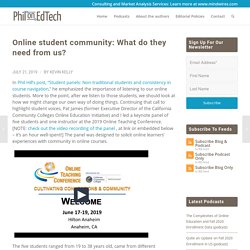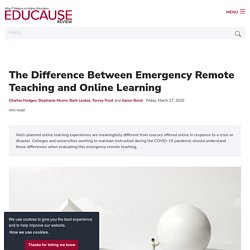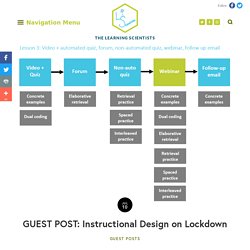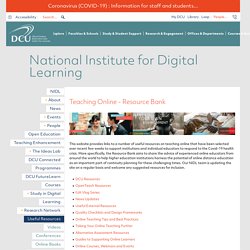

39118 iua student tips edtl v2 a3. Online student community: What do they need from us? - PhilOnEdTech. In Phil Hill’s post, “Student panels: Non-traditional students and consistency in course navigation,” he emphasized the importance of listening to our online students.

More to the point, after we listen to those students, we should look at how we might change our own way of doing things. Continuing that call to highlight student voices, Pat James (former Executive Director of the California Community Colleges Online Education Initiative) and I led a keynote panel of five students and one instructor at the 2019 Online Teaching Conference. [NOTE: check out the video recording of the panel , at link or embedded below – it’s an hour well-spent!] The panel was designed to solicit online learners’ experiences with community in online courses. The five students ranged from 19 to 38 years old, came from different backgrounds, and took online courses for different reasons.
The Difference Between Emergency Remote Teaching and Online Learning. Well-planned online learning experiences are meaningfully different from courses offered online in response to a crisis or disaster.

Colleges and universities working to maintain instruction during the COVID-19 pandemic should understand those differences when evaluating this emergency remote teaching. Due to the threat of COVID-19, colleges and universities are facing decisions about how to continue teaching and learning while keeping their faculty, staff, and students safe from a public health emergency that is moving fast and not well understood. Many institutions have opted to cancel all face-to-face classes, including labs and other learning experiences, and have mandated that faculty move their courses online to help prevent the spread of the virus that causes COVID-19. The list of institutions of higher education making this decision has been growing each day. The temptation to compare online learning to face-to-face instruction in these circumstances will be great. GUEST POST: Instructional Design on Lockdown — The Learning Scientists.
Would look like Video1 + Quiz1 Video2 + Quiz2 Video3 + Quiz3 or, perhaps Video1a + Video1b + Video1c + Quiz1 Video2a + Video2b + Video2c + Quiz2 Video3a + Video3b + Video3c + Quiz3 Coupling each video with a quiz helps, your learners to take an active role towards their learning, and you have a clearer picture of both their engagement and understanding.

Quizzes tend to enhance learners’ focus on the videos. Quizzes likewise tend to be viewed positively by students and have a high engagement rate. An immediate quiz this way, does not bring the student a tremendously ‘desirable difficulty’ as Robert Bjork would call it: it is not difficult for a student to remember and therefore does not do as much to reinforce long-term learning as one that might appear a day or two later (7). What a coupled or adjacent quiz like this does do, however, is more fundamental in that it checks students understood the content. Here I would couple a quiz with each video. Forum discussion Follow-up email Webinar Conclusion.
GUEST POST: Instructional Design on Lockdown — The Learning Scientists. Creating an Online Community, Class or Conference - Quick Tech Guide. Swiftly Moving Online: Links and Resources. Teaching Online - Resource Bank This website provides links to a number of useful resources on teaching online that have been selected over recent few weeks to support institutions and individual educators to respond to the Covid-19 health crisis.

More specifically, the Resource Bank aims to share the advice of experienced online educators from around the world to help higher education institutions harness the potential of online distance education as an important part of continuity planning for these challenging times. Our NIDL team is updating the site on a regular basis and welcome any suggested resources for inclusion. The following DCU resources may be of interest to other institutions and educators in developing their own continuity responses: • Loop Guides The Loop Staff Support Guide only accessible through Loop offers a suite of resources available to support online teaching and there is a similar Loop 101 for Students guide. • Keep Teaching • Keeping Learning • Discover DCU 3. 5. EEF Blog: Does research on ‘retrieval practice’ translate into classroom practice? EEF senior associate Prof. Rob Coe explains why, though there is lots of evidence to support the use of retrieval practice, there is still a question mark about how effectively it can be incorporated by teachers into lessons...
For the first ever EEF Teacher Choices trial, we are working with 70 science teachers to compare the impact of starting a lesson with a retrieval quiz, or starting with a discussion to engage interest. Retrieval practice is strongly supported by over 100 years of research and is one of only two learning techniques rated by Dunlosky et al (2013) as having ‘high utility’ for classroom practice. It is also growing massively in popularity in England. Indeed, some teachers we spoke to when planning the trial were concerned that we wouldn’t be able to find enough teachers who were not already using retrieval practice in the classroom. Well, yes and no. There is a colossal amount of research to support the use of retrieval practice. Brainstorming and Voting Amazingly Easy. Free Online Tool
Find the best solution by involving your friends, colleagues or clients.

A feedback session with customers or the decision on the new logo. tricider is the easiest way, to gather all opinions and ideas. It´s brainstorming and voting, all in one and online! Even hard decisions can be easy with tricider.